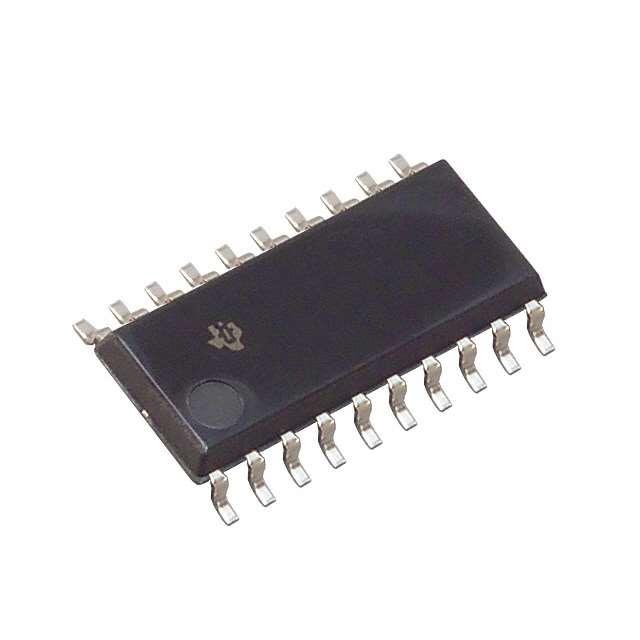Voir les spécifications pour les détails du produit.

SN74ABT623NSR
Product Overview
- Category: Integrated Circuit (IC)
- Use: Data Bus Transceiver
- Characteristics: High-speed, Bi-directional, 8-bit, Non-inverting
- Package: SOIC (Small Outline Integrated Circuit)
- Essence: Transfers data between two bidirectional buses
- Packaging/Quantity: Tape and Reel, 2500 units per reel
Specifications
- Supply Voltage Range: 4.5V to 5.5V
- Input Voltage Range: 0V to VCC
- Output Voltage Range: 0V to VCC
- Operating Temperature Range: -40°C to +85°C
- Maximum Propagation Delay: 6ns
- Maximum Operating Frequency: 100MHz
Detailed Pin Configuration
The SN74ABT623NSR has a total of 20 pins. The pin configuration is as follows:
- OE (Output Enable) A
- I/O0A (Bidirectional Data Bus Bit 0) A
- I/O1A (Bidirectional Data Bus Bit 1) A
- I/O2A (Bidirectional Data Bus Bit 2) A
- I/O3A (Bidirectional Data Bus Bit 3) A
- GND (Ground)
- I/O4A (Bidirectional Data Bus Bit 4) A
- I/O5A (Bidirectional Data Bus Bit 5) A
- I/O6A (Bidirectional Data Bus Bit 6) A
- I/O7A (Bidirectional Data Bus Bit 7) A
- VCC (Supply Voltage)
- DIR (Direction Control)
- OE (Output Enable) B
- I/O0B (Bidirectional Data Bus Bit 0) B
- I/O1B (Bidirectional Data Bus Bit 1) B
- I/O2B (Bidirectional Data Bus Bit 2) B
- I/O3B (Bidirectional Data Bus Bit 3) B
- GND (Ground)
- I/O4B (Bidirectional Data Bus Bit 4) B
- I/O5B (Bidirectional Data Bus Bit 5) B
Functional Features
- Bi-directional data transfer between two buses
- Non-inverting logic levels
- High-speed operation
- Output enable control for each bus
- Direction control for selecting the data flow
Advantages and Disadvantages
Advantages: - High-speed operation allows for efficient data transfer - Non-inverting logic levels ensure compatibility with various systems - Output enable control provides flexibility in managing bus communication - Direction control enables easy selection of data flow direction
Disadvantages: - Limited to 8-bit data bus width - Requires external control signals for proper operation
Working Principles
The SN74ABT623NSR is a bidirectional data bus transceiver that facilitates data transfer between two buses. It operates based on the control signals provided through the OE (Output Enable) and DIR (Direction Control) pins. When the OE pin is enabled, the transceiver allows data to flow bidirectionally between the A and B buses. The DIR pin determines the direction of data flow, either from A to B or from B to A.
Detailed Application Field Plans
The SN74ABT623NSR can be used in various applications where bidirectional data transfer is required. Some potential application fields include:
- Microprocessor Systems: Facilitating communication between the microprocessor and peripheral devices.
- Data Communication Networks: Enabling data exchange between different network nodes.
- Industrial Automation: Supporting data transfer between control systems and sensors/actuators.
- Automotive Electronics: Facilitating communication between different electronic modules in vehicles.
- Consumer Electronics: Enabling data transfer between various components in audio/video systems.
Detailed and Complete Alternative Models
- SN74ABT623A: Similar to SN74ABT623NSR, but available in a different package (PDIP).
- SN74ABT623D: Similar to SN74ABT623NSR, but available in a different package (SOIC Wide).
- SN74ABT623PW: Similar to SN74ABT623NSR, but available in a different package (TSSOP).
These alternative models offer similar functionality and characteristics as the SN74ABT623NSR, providing options for different packaging requirements.
Word count: 439 words
Énumérez 10 questions et réponses courantes liées à l'application de SN74ABT623NSR dans les solutions techniques
Sure! Here are 10 common questions and answers related to the application of SN74ABT623NSR:
Q: What is SN74ABT623NSR? A: SN74ABT623NSR is a specific type of integrated circuit (IC) commonly used in digital systems for bus transceiver applications.
Q: What is the purpose of SN74ABT623NSR? A: SN74ABT623NSR acts as a bidirectional buffer, allowing data to be transmitted between two buses with different voltage levels or signal formats.
Q: What voltage levels does SN74ABT623NSR support? A: SN74ABT623NSR supports a wide range of voltage levels, typically from 2.0V to 5.5V, making it compatible with various digital systems.
Q: How many channels does SN74ABT623NSR have? A: SN74ABT623NSR has 8 channels, which means it can handle up to 8 separate data lines simultaneously.
Q: Can SN74ABT623NSR be used for level shifting? A: Yes, SN74ABT623NSR can be used for level shifting as it provides bidirectional voltage translation between different voltage domains.
Q: What is the maximum data rate supported by SN74ABT623NSR? A: SN74ABT623NSR can support high-speed data rates up to several hundred megabits per second (Mbps), depending on the specific application.
Q: Does SN74ABT623NSR have any built-in protection features? A: Yes, SN74ABT623NSR includes built-in ESD (electrostatic discharge) protection diodes to safeguard against electrostatic damage.
Q: Can SN74ABT623NSR be used in both input and output applications? A: Yes, SN74ABT623NSR can be used as both an input buffer and an output driver, making it versatile for various digital system designs.
Q: What is the power supply voltage range for SN74ABT623NSR? A: SN74ABT623NSR typically operates with a power supply voltage ranging from 4.5V to 5.5V.
Q: Are there any specific layout considerations when using SN74ABT623NSR? A: Yes, it is recommended to follow proper PCB layout guidelines, such as minimizing trace lengths and ensuring adequate decoupling capacitors, to optimize performance and minimize noise.
Please note that these answers are general and may vary depending on the specific application and requirements.

